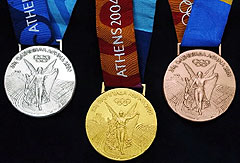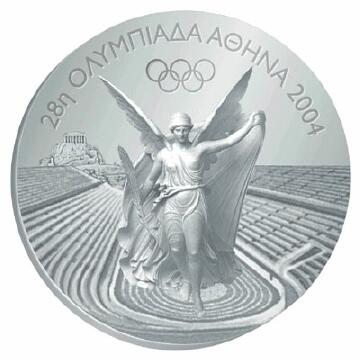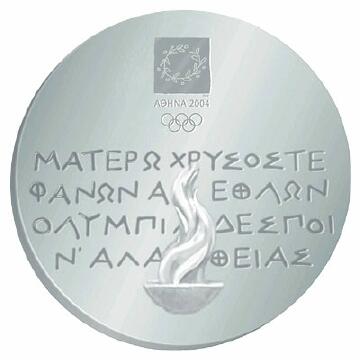




The main feature of the medals is the Greek
character shown on both sides, since their basic side has been
changed for the first time since the Amsterdam Olympic Games in
1928.
This is of particular importance, as from now on all Olympic medals
will reflect the Greek character of the Games as regards both
their origin and their revival.
On the medals awarded to Olympic athletes from 1928 until the
Sydney Games, goddess Nike was seated, holding an ear of corn
in one hand and a wreath in the other.
Here, she flies into the
stadium bringing victory to the best athlete.
The Organising Committee has chosen to show the Panathenic stadium,
where the Games were first renewed in 1896.
On the obverse, the athlete’s
discipline will also be engraved.
The reverse side of the medal is composed of three elements ---
(1) - The eternal flame that will be lit in Olympia and will travel
through the five continents by way of the 2004 Torch Relay
(2) - The opening lines of Pindar's Eighth Olympic Ode composed
in 460 BC to honour the victory of Alkimedon of Aegina in wrestling
and
(3) - The ATHENS 2004 Olympic Games emblem.
The design of the Medal was created by Elena Votsi.
The total number of medals to be produced is 1,130 gold, 1,130
silver, and 1,150 bronze.
The Olympic Games medals are one of the most
important design applications, since they are given to the athletes,
the real protagonists and heroes of the Olympic Games.
The medals for the Athens Games were presented on July 2nd 2003,
in Prague.
The main side of the medals has been changed for the first time
since the Amsterdam Olympic Games in 1928.
The main feature of the medals is the Greek character shown on
both sides, which is of particular importance, as from now on
all Olympic medals will reflect the Greek character of the Games
regarding both their origin and their revival.
ATHENS 2004 aim was to modify the main side of the medals and
to include Greek elements in it that would highlight the close
connection between Greece and the Olympic Movement.
Therefore ATHENS 2004 asked the candidates that took part at the
competition to include the goddess “Nike” of Paeonios
and the Panathinaikon Stadium in their design.
Goddess Nike was worshipped as the personification of victory
in the stadium as well as in the batlefield.
According to Greek mythology, Zeus sent her to earth to crown
the winners.
Historical research has showed that goddess Nike was always represented
as “winged”, full of movement and dynamism, descending
from heaven either to sing praises for a victory, or to offer
libations, or to crown a winner.
Moreover, in the Museum of Olympia there is a statue of goddess
Nike, three metres in height, created in 421 BC by the well-known
sculptor Paeonios.
Supported by a nine-metre triangular pedestal situated at the
east facade of the Temple of Zeus, she gave the impression that
she was descending from heaven.
Since goddess Nike would
fly into a stadium to crown the best athlete, at the main side
of the medals she is represent in a similar way in the interior
of a stadium, and more particularly in the Panathinaikon Stadium
where the Olympic Games were revived in 1896.
The main side of the medals will also include the sport in which
the athlete won it.
On the contrary, on the medals awarded to Olympic athletes from
1928 until the Salt Lake Games, goddess Nike was seated, holding
an ear of corn in one hand and a wreath in the other, while the
second element of the main side was the exterior of an arena that
resembled the Colosseum.
There are three elements
on the second side of the medals ---
(1) - The first is the eternal flame that will be lit in Olympia
and will travel through the five continents by way of the 2004
Torch Relay.
(2) - The flame is accompanied by the opening lines of Pindar’s
Eighth Olympic Ode composed in 460 BC to honour the victory of
Alkimedon of Aegina in wrestling.
(3) - The design of the second side of the medals is completed
with the ATHENS 2004 Olympic Games emblem.
The design of the medal was created by Elena Votsi
Athens, 20 July 2004
Olympic Medals now being Struck
Thirteen kilos of pure gold, about a ton of silver, and about
a ton of bronze.
These are the ingredients for the 2004 Olympic and Paralympic
Games medals.
Production is already under way.
For the first time since Amsterdam 1928, and with IOC approval
of an ATHENS 2004 proposal made in June 2003, Olympic medals once
more have a Greek look.
On the obverse of the Athens
medals will be the statue of Nike by Paeonius, placed in the Panathinaiko
(Panathenian) Stadium where the Games where revived in 1896, with
the Acropolis in the background.
The reverse will show the flame from the Olympic Torch Relay;
a quotation from Pindar's Eighth Olympian; the ATHENS 2004 emblem;
and the name of the sport for which the medal has been awarded.
The design of the medal is by Elena Votsi and the relief is by
Kostas Kazakos.
Nearly 3000 medals will be cut: 986 gold, 986 silver, and 1150
bronze.
HOW MEDALS ARE MADE
Striking of medals begins with the creation of the model by the
artist, based on an original design.
The first model is made in plasticine, then in plaster.
The artist sculpts a three-dimensional prototype of the medal.
Then a high-accuracy scanner is used to transfer the digital image
into a pantograph, which carves the steel mould.
(Medal production started immediately after ATHENS 2004 had approved
the model, about a month ago)
Before going into production, the mould undergoes a process to
make it more resistant to pressure.
In production powerful presses will be used on the discs of silver
or bronze to fashion the image on both sides of the medal.
Bronze and silver medals are struck from pure bronze and pure
silver, using one and the same process.
Gold medals require a special process, with a coat of gold of
a particular thickness - matching IOC specifications - being laid
on the base of silver of which the medal is made.
All medals are sent to be finished by the hands of expert craftsmen
in the following phase of production.
Medals destined to be gold medals have their own separate path.
Striking gold medals
Srtiking gold medals for the Olympic and Paralympic Games calls
for a special process.
After being finished, gold medals are sent to a certified Swiss
laboratory, working in partnership with the IOC, for their coating
of gold.
The medals are coated with a deep layer of gold, by an electrolytic
process of absolute accuracy.
For gold medals for the Olympic and Paralympic Games ATHENS 2004
will use up a total of 13 kilograms of gold.
Each medal is coated with 6 grams of pure gold.
The gold used is 75 microns deep, as per IOC specifications -
deeper than the ordinary coating process which only has a depth
of 50 microns.
The medal is then chased with a special enamel and is returned
- now truly a golden medal - to Greece so that the name of the
sport can be engraved on it.
A ribbon is attached to the back of the medal and it is couched
in a box specially designed by EFSIMON in consultation with ATHENS
2004.
Each medal weighs roughly 150 gm and is 60 mm in diameter.
(This does not take into account the ribbon for hanging the medal,
which is 5 mm high and 3.5 cm wide)
The production process is laborious.
A maximum of 150 medals can be produced a day, as there is very
strict quality control.
The gold and silver are from Switzerland, the bronze is from Greece.
EFSIMON's president Nikos Konstantopoulos is at pains to point
out that the only part of the production done in Switzerland is
the gold plating; the remainder of the production all takes place
in Greece.
There are a total of fifteen employees working at the company's
premises in Aspropyrgos, either as electronics specialists, to
operate the hi-tech machinery, or as machiners, or as goldsmiths,
to applying the finishing touches.